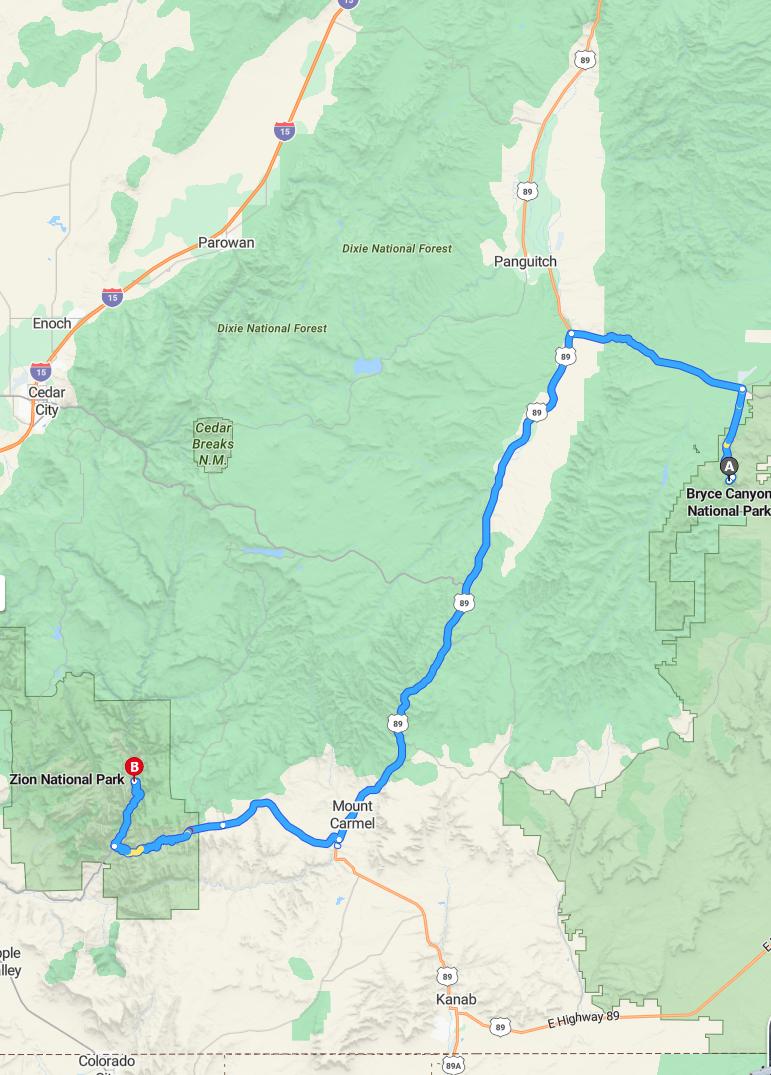Distance and estimated driving time
The drive from Bryce to Zion National Park covers approximately 93 miles along US-89 S and UT-9, taking about 2 hours and 13 minutes. This scenic route offers travelers a convenient and picturesque journey between these popular Utah destinations. The drive provides a comfortable balance of travel time and stunning desert landscapes. Planning accordingly ensures a smooth trip to enjoy the natural beauty of Zion National Park.
Driving route
Traveling from Bryce Canyon National Park to Zion National Park offers a scenic and enjoyable journey through some of Utah's most stunning landscapes. Starting at Bryce Canyon, visitors can explore its iconic hoodoos and vibrant rock formations. The drive then takes you southward through Mount Carmel, a charming town known for its proximity to impressive sandstone cliffs and picturesque vistas. As you approach Zion, the verdant scenery shifts to dramatic canyons and towering cliffs, culminating in the majestic beauty of Zion National Park. This route exemplifies the diverse geological wonders of the region and provides a memorable outdoor adventure.

Scenic spots and viewpoints along the route
As you drive from Bryce Canyon to Zion National Park, you'll encounter several breathtaking scenic spots and viewpoints that showcase the area's natural beauty. Starting at Bryce Canyon, take in the stunning vistas of the iconic hoodoos and vibrant rock formations at Sunrise Point and Sunset Point. As you approach Mount Carmel, enjoy panoramic views of the winding cliffs and lush landscapes that lead into Zion. Finally, before reaching Zion National Park, stop at the Checkerboard Mesa viewpoint to marvel at the unique patterned sandstone, completing a scenic journey through some of Utah's most spectacular landscapes.
Best time of day to travel
The best time of day to travel from Bryce Canyon to Zion National Park is early in the morning, shortly after sunrise, when the temperatures are cooler and the roads are less crowded. Traveling during mid-morning or late afternoon can also be enjoyable, as the lighting enhances the stunning landscape views, and there are fewer vehicles on the road. Avoiding midday hours is advisable, especially during peak seasons, to escape the heat and heavy traffic. Overall, starting your journey early ensures a more relaxed experience and the opportunity to fully appreciate the scenic beauty along the route.
Road conditions and safety tips
Traveling from Bryce Canyon to Zion National Park offers a scenic journey through diverse landscapes, but drivers should stay alert to varying road conditions. The route includes winding mountain roads and some steep inclines, so maintaining a safe speed and staying vigilant is essential. Always check weather updates before departure, as snow or rain can affect driving safety, especially in higher elevations. Additionally, ensure your vehicle is in good condition, carry plenty of water and emergency supplies, and be prepared for limited cell service in remote areas.
Parking options at Zion National Park
Zion National Park offers a variety of parking options to accommodate visitors, including the large Zion Visitor Center parking lot, which is ideal for first-time visitors and those accessing the shuttle system. For additional convenience, there are parking areas near popular trailheads such as Angels Landing and The Grotto, though these can become crowded during peak times. The park also provides seasonal and overflow parking facilities, as well as designated spots for RVs and larger vehicles. Visitors are encouraged to arrive early or consider using the park's shuttle system to reduce congestion and ensure easier access to key sites within the park.
Recommended stops for sightseeing and photography
When driving from Bryce Canyon to Zion National Park, there are several highly recommended stops for sightseeing and photography. First, Bryce Canyon offers stunning hoodoos and unique rock formations that are perfect for capturing vibrant sunrise or sunset shots. Next, a stop at Mount Carmel provides breathtaking views of colorful cliffs and the winding Zion-Mount Carmel Highway, ideal for scenic photography. Finally, Zion National Park itself features impressive canyons and towering sandstone cliffs, making it a must-visit destination for nature enthusiasts and photographers alike. These stops promise a memorable journey filled with stunning vistas and unforgettable photo opportunities.
Facilities and services available en route
Traveling from Bryce Canyon to Zion National Park offers a variety of facilities and services along the route. Visitors can find rest areas and parking at key points such as Bryce Canyon and Mount Carmel, providing convenient spots for breaks and sightseeing. Numerous amenities, including information centers, gift shops, and dining options, are available within the parks and nearby towns to enhance the visitor experience. Additionally, the route features well-marked roads and scenic viewpoints, ensuring a comfortable and enjoyable journey through this stunning region.
Local dining and refreshment options
While traveling from Bryce Canyon to Zion National Park, visitors can enjoy a variety of local dining and refreshment options along the route. In Mount Carmel, there are charming cafes and casual eateries offering delicious local cuisine and refreshing beverages, perfect for a quick break. Once in Zion, the park's surrounding towns feature a range of restaurants, from cozy diners to more upscale options, providing hearty meals and local specialties. Additionally, numerous snack bars and refreshment stands are available throughout Zion to help hikers and travelers recharge during their adventures.
Travel tips for a smooth journey
To ensure a smooth journey from Bryce Canyon to Zion National Park, start early in the morning to avoid peak hour traffic and maximize sightseeing opportunities. Keep your vehicle fueled and carry some snacks and water, especially near Mount Carmel, where amenities may be limited. Plan your stops in advance, allowing time to explore Bryce Canyon and Mount Carmel scenic areas along the way. Lastly, stay updated on park conditions and road closures through official websites or apps to prevent any unexpected delays.
